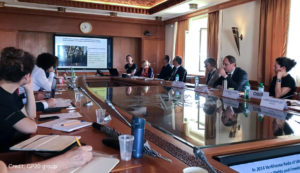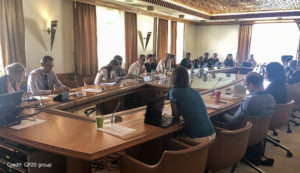“Protracted displacement is a humanitarian issue, but it is also a process of social and economic impoverishment. (…) It’s not only a problem for IDPs but also for host communities, and there is a risk of undermining state policies (and even) jeopardizing the Sustainable Development Goals. I’ve come to the conclusion that yes, protracted displacement is a humanitarian challenge but it’s primarily a development and political challenge (linked to) policies and lack or availability of political will.”
We couldn’t agree more with Prof. Walter Kaelin, Special Advisor to the RC/HC in Somalia and Ukraine on Protracted Internal Displacement. As the recent meeting of the group working on the implementation of the GP20 Plan of Action underlined, durable solutions must be a priority for the whole sector, and need to be thought through from day one of a displacement crisis. However, as JIPS’ Coordinator Natalia Baal put it, given the evident synergies across many contexts, today the question isn’t about what needs to happen, but how this can be achieved.
It was informative to hear from the respective government representatives about how durable solutions are being approached in Afghanistan, Iraq, Somalia and Ukraine. Interestingly, despite the vastly different displacement contexts there are remarkable commonalities between the experiences of these four countries in working towards solutions for IDPs (and as a matter of fact, these overlap with our observations from various profiling exercises in recent years). Building on the country presentations at the GP20 event, here we’d like to focus in on the following three key success factors:
These recommendations were encouraging for us at JIPS as each one speaks concretely to ongoing priorities we are working to mainstream in our work. The first links to better solutions analysis, even when displacement situations have not yet settled; the second connects to our field support request prioritisation criteria, our investment in EGRIS and our capacity building priorities, which emphasises working with national and local governments; the third links to our efforts – where admittedly we still have much work to do – on engaging IDPs and affected communities in profiling processes more proactively to enhance use and relevance of results.

The GP20 Steering Group meeting on durable solutions included a high-level panel composed of: Cecilia Jimenez-Damary, UN Special Rapporteur on the human rights of IDPs; Prof. Walter Kaelin, Special Advisor to the RC/HC in Somalia and Ukraine on Protracted Internal Displacement; HE Vadym Chernysh (Ukraine); Shoaib Timory (Afghanistan); Zahra Abdi Mohamed (Somalia); HE Hussain Mahmood Alkhateeb (Iraq). Credit: GP20 group | Martina Caterina.
HE Vadym Chernysh, Minister of Temporarily Occupied Territories and IDPs in Ukraine, brought the room straight to the point: while the national strategy on the implementation of durable solutions to internal displacement, adopted in 2017, provided a fruitful foundation for relevant efforts, putting it to action proved challenging. In fact, to enable the broad collaboration needed for effective solutions, deeply rooted mentalities had to be tackled first. Specifically, this meant changing the focus among the various stakeholders – central governments and local authorities but also humanitarian and development actors and NGOs – to adopt a longer-term perspective, away from long-established habits of meeting humanitarian needs through assistance provision.
For Cecilia Jimenez-Damary, UN Special Rapporteur on the human rights of IDPs, there is also an urgent need to move away from the widespread focus on location when it comes to durable solutions, towards one on vulnerabilities:
“Many actors still consider returns as the primary – or worse – only solution. (… However,) in situations of protracted displacement, generations have grown up and local integration is often more viable than return.”
For effective and long-term solutions, she emphasised, we must invest in stronger and more comprehensive analysis that considers vulnerabilities, intentions, preferences, obstacles and capacities of IDPs (as demonstrated by the last GP20 steering group meeting on data). The IASC Framework on Durable Solutions for IDPs and related tools and guidance provide useful instruments for such an exercise.
All four country examples gave a clear message: government leadership is critical to successfully address internal displacement and progress towards solutions, and this is even more the case in protracted situations. According to Zahra Abdi Mohamed, Director for Durable Solutions, in Somalia a collaborative profiling exercise, undertaken in 2015-16, laid the foundation for the Durable Solutions Initiative and enabled the evidence-based inclusion of IDPs in the National Development Plan.
The national-level coordination platform Migration, Displacement and Durable Solutions sub-working group ensures, through a whole-of-government approach, the implementation of durable solutions to displacement under the framework of the National Development Plan. In addition, the Durable Solutions Unit within the Ministry of Planning, Investments and Economic Development works directly with the UN Resident Coordinator’s Office and the Regional Durable Solutions Secretariat (ReDSS) to strengthen durable solutions programming. At the local level, coordination efforts with local administrations are vital, as was demonstrated by the positive developments in the Benadir Region/Mogadishu.
In Afghanistan, a Steering Committee, composed of representatives of the Ministry of Refugees and Repatriation and the Ministry of Labour, oversees the implementation of the national policy on internal displacement. As Shoaib Timory, Deputy Permanent Representative at the Permanent Mission in Geneva, explained, this Committee works to ensure that the needs of IDPs are taken into account in plans at national and provincial levels.
A similar approach is taken in Iraq, explained HE Hussain Mahmood Alkhateeb, Permanent Representative of Iraq to the UN in Geneva: a High-Level Committee headed by the Ministry of Migration and Displacement is leading the response to internal displacement. It was also illustrated by the case of Ukraine, where the Minister stressed how important it was to highlight that integration of IDPs is the responsibility of all ministries, and therefore work needs to be done to convince those who are not aware of the issue.

Credit: GP20 group | Martina Caterina
Parallel systems and services must be avoided as much as possible, and strategies of inclusion should be enhanced. This point was addressed by all speakers in different ways. Prof. Walter Kaelin highlighted the positive impact of bottom-up interventions that include the perspectives of IDPs and displacement affected populations. The added value of IDP participation was also echoed in remarks from Cecilia Jimenez-Damary who has made this issue a top priority for her Mandate.
An example from Iraq was particularly revealing: the Government developed innovative practices to increase effectiveness of a programme to issue national identification documents for all IDPs by allowing confirmation of identity by two witnesses. This enabled IDPs to access services, including cash assistance and vocational training, more easily and thereby enhanced integration by creating new livelihood opportunities for improved self-reliance.
Similar activities have been implemented in Afghanistan, e.g. through the Sustainable Afghanistan Livelihoods and Mobility (SALAM) project: tailored training programmes to help IDPs fill knowledge gaps and adapt to and integrate in new environments. As a matter of fact, as Prof. Walter Kaelin underlined, moving towards self-resilience and self-sufficiency for IDPs should be a priority from an early stage of a displacement crisis. Among others, this means ensuring the participation of IDPs and host communities in processes aimed at informing and supporting durable solutions to displacement.
Interestingly, all country presentations, in one way or another, highlighted the importance of data. However, in all of these cases, the crux isn’t so much about a lack of data. Instead, the issue is having the right type of data that is fit-for-purpose.
As mentioned during the event but also highlighted at the previous GP20 Steering Group meeting on data and evidence on internal displacement, this is more effectively achieved through joint efforts by government, humanitarian and development actors. Similarly, it calls for comprehensive durable solutions analysis that considers IDPs as well as host communities. Data collected solely with a short-term mindset aimed at informing only humanitarian assistance programmes, are insufficient for effective responses to internal displacement.
We look forward to continuing to work with partners through the GP20 group as well as in the context of specific profiling exercises, to facilitate such a culture of collaboration and help build locally-owned evidence that can underpin a whole-of-government approach to durable solutions. Clearly, for efforts towards durable solutions to be effective, there also needs to be adequate data and shared analysis, an enabling legal and policy environment, as well as participation of displaced persons and host communities themselves.